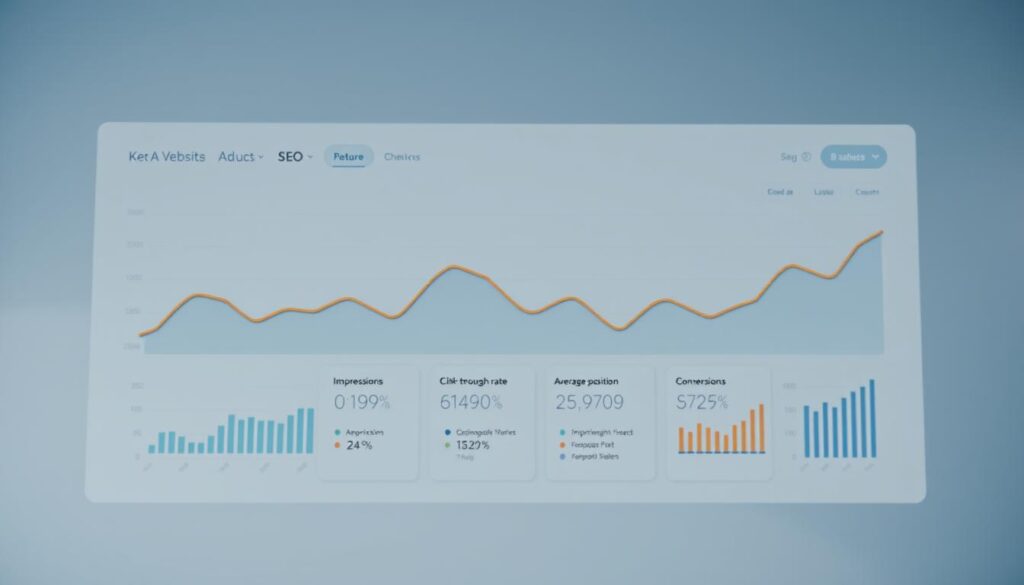Search engine technology is undergoing its most significant transformation in decades. Artificial intelligence now shapes how platforms organize and deliver information, creating a hybrid environment where conventional metrics coexist with new ranking factors. This evolution demands fresh strategies for maintaining visibility while adapting to machine learning-driven search behaviors.
Traditional SEO practices face unprecedented challenges as algorithms prioritize direct answers and contextual understanding over keyword density. Content creators must now balance technical optimization with semantic relevance, ensuring material satisfies both algorithmic requirements and user intent. The rise of AI-generated summaries further complicates measurement frameworks that once relied on straightforward position tracking.
Brands navigating this shifting landscape require tools that decode emerging patterns in search data. Advanced analysis techniques reveal how machine learning interprets queries, surfaces content, and prioritizes authoritative sources. These insights enable professionals to refine their digital strategies while accounting for real-time trends in user interactions.
Key Takeaways
- Search algorithms now prioritize contextual understanding over traditional ranking signals
- AI-generated summaries require updated measurement strategies for content performance
- Visibility depends on balancing technical SEO with semantic relevance
- Machine learning reshapes how search engines evaluate content quality
- Advanced analysis tools help decode evolving user search patterns
Introduction: The Evolving Search Landscape

Modern search systems now prioritize understanding over simple keyword matching. Nearly 50% of queries trigger AI-generated answers, reshaping how people access information online. This shift reduces reliance on traditional website links while creating new opportunities for strategic content optimization.
From Rules to Reasoning
Search engines now analyze context rather than just matching phrases. Machine learning models evaluate content quality through:
- Semantic relationships between concepts
- User engagement patterns across devices
- Cross-referenced authority signals
This evolution means ranking success increasingly depends on demonstrating expertise through comprehensive coverage of topics. For example, health-related queries now surface verified medical sources more frequently than generic blogs.
Why Adaptation Matters
AI-driven search changes user behavior. People increasingly accept answers from summary boxes rather than clicking through websites. Content creators must now optimize for:
- Featured snippet eligibility
- Conversational query patterns
- Multi-format responses (text, video, data)
Recent analysis shows pages optimized for AI tools achieve 37% higher visibility in hybrid search results. This hybrid approach combines traditional SEO with machine learning requirements, creating new pathways for audience engagement.
The Limitations of Traditional SEO Metrics

Digital marketers face measurement challenges as search evolves. Conventional tracking methods struggle to quantify success in environments where answers appear without clicks. This creates blind spots in assessing true online impact.
Understanding Classic KPIs in a Changing World
Organic traffic and click-through rates once reliably indicated campaign performance. Now, 42% of health-related queries trigger direct answers that satisfy users without website visits. Rankings remain stable, but visibility shifts to AI-summarized content.
CTR metrics grow unreliable when search engines display key data upfront. A travel blog might rank #1 for “best Tokyo hotels” yet see declining traffic if summaries list room rates and amenities. This disconnect demands revised success benchmarks.
Data Gaps in AI-Generated Results
Current tools can’t track how algorithms reference content for machine-generated answers. A cooking website might fuel recipe summaries without receiving attribution or clicks. This hidden influence skews performance analysis.
Three critical measurement gaps emerge:
- Undetected content usage in AI responses
- Mismatched ranking positions versus actual exposure
- Incomplete user intent tracking across formats
New solutions like AI analysis tools help bridge these gaps. They track brand mentions in summaries and measure indirect engagement patterns, providing clearer performance insights.
Harnessing AI-powered SERP insights for Strategic Advantage

Search optimization now demands dual-focus strategies that address both human readers and algorithmic systems. A 2024 SurferSEO study reveals pages in top-10 positions achieve 52% higher inclusion rates in machine-generated summaries. This creates opportunities to amplify visibility through content that serves multiple purposes.
Integrating Machine Intelligence with Content Strategy
High-ranking pages demonstrate stronger alignment with AI selection criteria. Technical analysis shows top-performing articles often use structured data formats and address user intent through comprehensive coverage. For example, a cybersecurity guide ranking #1 might fuel summary boxes about threat prevention without direct clicks.
Effective strategies blend traditional SEO with machine learning preferences. This involves:
- Prioritizing depth over breadth in topic exploration
- Implementing schema markup for clearer content categorization
- Balancing keyword usage with natural language patterns
Translating Analytics into SEO Enhancements
Data reveals where competitors dominate machine-generated answers despite similar organic rankings. Marketing teams using AI-driven analysis tools identify these gaps 40% faster. One travel brand improved summary appearances by 28% through competitor response mapping.
Optimization now requires monitoring two key metrics:
- Traditional ranking positions for core terms
- Content citation frequency in automated answers
This dual approach ensures resources deliver value across evolving search formats while maintaining engagement through direct visits.
Enhancing Organic Traffic and User Engagement in the AI Era

Search behavior shifts caused by automated answers demand revised approaches to audience retention. A 2024 Ahrefs study shows pages appearing alongside AI Overviews experience 34.5% lower click-through rates, with dual AI/Featured Snippet results suffering 37% declines. This trend forces marketers to rethink how they measure and cultivate organic traffic.
Tracking Click-Through Rates and Organic Traffic Shifts
High rankings no longer guarantee website visits. Travel industry data reveals pages maintaining #1 positions for queries like “best hiking gear” saw 22% fewer clicks after AI summaries launched. “Position tracking alone creates false confidence,” notes a Search Engine Journal analysis. “Marketers must monitor how often their content fuels automated answers without driving direct traffic.”
Advanced AI content analysis tools now map keyword correlations between ranking pages and machine-generated responses. This helps identify opportunities to create material that both satisfies algorithms and prompts user exploration beyond summaries.
Improving the User Experience Beyond AI Summaries
Winning user engagement requires content that adds unique value. Health websites achieving traffic growth despite AI competition often include interactive symptom checkers or personalized treatment guides. These elements encourage visits by offering what static summaries cannot.
Three critical focus areas emerge:
- Redesigning landing pages to reduce bounce rates through faster load times
- Incorporating multimedia elements that deepen topic understanding
- Optimizing conversion paths for users who’ve already consumed AI answers
Dwell time becomes a crucial metric, with pages retaining visitors for 3+ minutes showing 48% higher conversion rates. This underscores the need for material that delivers sustained user experience value in hybrid search environments.
Adapting Content Strategy for AI-Driven Search Trends

Content visibility now hinges on alignment with machine learning selection patterns. Keywords ranking below position 3 face 27% steeper click-through declines when AI summaries dominate results. This shift makes strategic positioning essential for maintaining relevance.
Optimizing Content for Featured Snippets and Direct Answers
Featured snippets remain critical engagement drivers despite AI advancements. Pages optimized for these elements achieve 19% higher visibility in hybrid results. Three key tactics improve selection rates:
| Factor | Traditional Approach | AI-Optimized Strategy |
|---|---|---|
| Structure | Long-form articles | Modular content blocks |
| Formatting | Paragraphs | Numbered lists & FAQs |
| Data Implementation | Basic schema | Multi-layered markup |
Industry-specific approaches prove vital. Travel brands using creative prompts in content creation saw 33% more AI citations. Healthcare sites improved answer-box appearances by 41% through symptom-focused Q&A formats.
Technical enhancements boost algorithmic recognition. Structured data implementation increases content selection likelihood by:
- Clarifying section purposes for AI crawlers
- Highlighting statistical evidence
- Identifying priority information clusters
Focusing on transactional queries counters traffic erosion from AI summaries. High-intent searches like “emergency roof repair near me” maintain 68% click-through rates despite automated answers. This strategy preserves organic growth while adapting to search trends.
Tracking New SEO Metrics in an AI-First Landscape
The measurement of digital success now requires tracking metrics that didn’t exist two years ago. As algorithms increasingly generate answers rather than list links, brands must monitor novel indicators of influence. This shift creates opportunities to quantify impact beyond traditional click-based analytics.
Monitoring AI Brand Mentions and Linked References
Brand visibility now extends to unlinked mentions in machine-generated responses. A recent study found 62% of AI answers reference companies without including website links. This requires tracking tools that identify:
- Direct brand citations in summaries
- Competitor dominance in key topic responses
- Contextual associations with industry terms
| Metric Type | Traditional Approach | AI-First Method |
|---|---|---|
| Brand Mentions | Backlink monitoring | Unattributed citation tracking |
| Link Tracking | Domain authority analysis | Linked reference impact scoring |
| Visibility Measurement | Rank position tracking | AI overview inclusion rates |
Platform-specific performance analysis reveals disparities across systems. Brands appear 73% more frequently in Google AI Overviews than ChatGPT responses for commercial keywords, according to 2024 data. This demands tailored strategies for each environment.
Evaluating Conversion Influence and Engagement
Content exposed through AI answers drives conversions even without direct visits. A retail brand using advanced SEO metrics frameworks discovered 41% of sales involved AI-summarized product details. Three critical tracking areas emerge:
- Extended attribution windows for AI-influenced conversions
- Cross-channel engagement patterns
- Content depth required to trigger citations
Visibility scoring systems now assess how often brands appear across multiple AI platforms. Companies achieving high scores demonstrate 28% better customer retention rates. This metric helps quantify competitive positioning in evolving search landscapes.
Utilizing Innovative Tools for SERP Analysis
Advanced analytical platforms now decode patterns in machine-generated search results. These solutions track visibility across traditional listings and automated summaries, offering actionable data for strategic adjustments. Professionals gain clarity on how algorithms reference content while identifying gaps in competitor strategies.
Leveraging AI Tools for Competitor Insights
Specialized platforms like Keyword.com’s tracker reveal which terms trigger automated answers. This helps prioritize updates for pages ranking outside AI overviews. Marketing teams using advanced SERP analysis techniques identify content gaps 31% faster than manual methods.
Three critical capabilities define modern analysis tools:
- Cross-platform tracking of brand mentions in summaries
- Competitor content performance comparisons
- Historical data for trend identification
Interpreting Data from Google’s AI Overviews and Beyond
Effective optimization requires understanding how algorithms select source material. Pages with structured data markup appear 47% more frequently in overviews according to recent case studies. This technical enhancement clarifies content purpose for machine evaluation.
Strategic implementation involves:
- Monitoring keyword correlations between rankings and AI citations
- Analyzing content depth required for selection
- Tracking algorithm updates through performance shifts
Brands using cutting-edge AI solutions achieve 22% higher overview inclusion rates within six months. Continuous data review ensures strategies adapt as search systems evolve.
Conclusion
The integration of artificial intelligence into search systems has fundamentally altered visibility dynamics. Analysis of 700,000 keywords reveals AI Overviews now claim 15.49% of organic traffic share, demanding strategic countermeasures. This shift requires businesses to optimize for dual objectives: algorithmic recognition and human engagement.
Successful adaptation combines Featured Snippet refinement with high-intent keyword targeting. Brands maintaining competitive positions leverage tools that track content citations in machine-generated results. Comprehensive monitoring frameworks now measure both traditional rankings and AI-driven brand mentions.
Emerging trends favor organizations blending technical SEO with adaptive content strategies. Those employing structured data markup and modular content formats achieve 47% higher inclusion rates in automated summaries. Presentation optimization tools demonstrate how visual content enhances multi-format visibility across search platforms.
Future-proof strategies demand continuous analysis of evolving search patterns. By aligning with machine learning preferences while delivering unique user value, businesses can offset CTR declines. The new search landscape rewards those who master hybrid optimization – balancing algorithmic requirements with audience needs.







